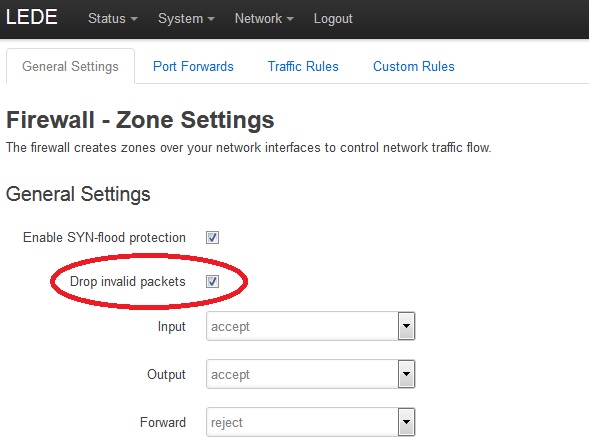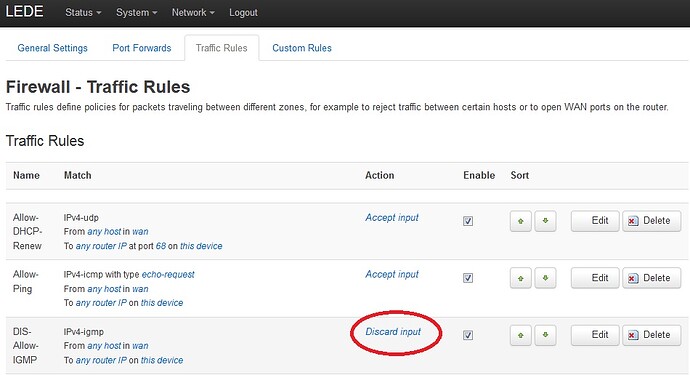Scenario:
A large building with 300 fiber internet access and 25 access points distributed throughout the building. Before installing the fiber there was a conventional ADSL and everything worked perfectly, but as soon as the fiber was installed the access points were saturated and the Wi-Fi network came down mostly in just 5 hours. This is a known problem. A Mikrotik router was set up and all the multicast traffic ranges were cut and IGMP was activated, and we got the network to last a week without falling, but finally it kept falling.
Finally another technician changed the configuration of the Mikrotik and everything works perfectly since then.
What I want is to know if that configuration can be played on a router with LEDE firmware.
/queue type
add kind=pcq name=DOWNLOAD pcq-classifier=dst-address \
pcq-dst-address6-mask=64 pcq-src-address6-mask=64 pcq-total-limit=\
5000KiB
add kind=pcq name=UPLOAD pcq-classifier=src-address \
pcq-dst-address6-mask=64 pcq-src-address6-mask=64 pcq-total-limit=\
5000KiB
/queue tree
add max-limit=170M name="QOS Download" parent=bridge1 queue=DOWNLOAD
add limit-at=3M max-limit=170M name="PRI 1" packet-mark=pm_prio1 parent=\
"QOS Download" priority=1 queue=default
add limit-at=100M max-limit=170M name="PRI 3" packet-mark=pm_prio3 \
parent="QOS Download" priority=3 queue=default
add limit-at=5M max-limit=170M name="PRI 2" packet-mark=pm_prio2 parent=\
"QOS Download" priority=2 queue=default
add name="PRI 4" packet-mark=pm_prio4 parent="QOS Download" priority=4 \
queue=default
add limit-at=30M max-limit=170M name="PRI 5" packet-mark=pm_prio5 \
parent="QOS Download" priority=5 queue=default
add limit-at=30M max-limit=170M name="PRI 6" packet-mark=pm_prio6 \
parent="QOS Download" priority=6 queue=default
add limit-at=5M max-limit=170M name="PRI 7" packet-mark=pm_prio7 parent=\
"QOS Download" priority=7 queue=default
add limit-at=512k max-limit=170M name="PRI 8" packet-mark=pm_prio8 \
parent="QOS Download" queue=default
add max-limit=10M name="QOS UPLOAD" parent=pppoe-out1-fibra queue=UPLOAD
add limit-at=20M max-limit=30M name="PRI 3 UPLOAD" packet-mark=pm_prio3 \
parent="QOS UPLOAD" priority=3 queue=default
/ip firewall filter
add action=drop chain=input comment="BLOCK EXTERNAL DNS" dst-port=53 \
in-interface=pppoe-out1-fibra protocol=udp
add action=accept chain=input comment="ACCEPT ESTABLISHED CONNECTIONS" \
connection-state=established
add action=accept chain=input comment="ACCEPT RELATED CONNECTIONS" \
connection-state=related
add action=drop chain=input comment="DROP INVALID PACKETS" \
connection-state=invalid
/ip firewall mangle
add action=log chain=notes comment="\C1rbol QoS 18/10/2016"
add action=jump chain=forward connection-mark=no-mark jump-target=\
conmark
add action=jump chain=forward connection-mark=!no-mark jump-target=\
pktmark
add action=mark-connection chain=conmark comment=\
"Priority 1: Administration Services" new-connection-mark=\
cm_prio-1 passthrough=yes protocol=icmp
add action=mark-connection chain=conmark new-connection-mark=cm_prio-1 \
protocol=ospf
add action=mark-connection chain=conmark new-connection-mark=cm_prio-1 \
protocol=ipip
add action=mark-connection chain=conmark new-connection-mark=cm_prio-1 \
protocol=gre
add action=mark-connection chain=conmark new-connection-mark=cm_prio-1 \
protocol=ipsec-esp
add action=mark-connection chain=conmark new-connection-mark=cm_prio-1 \
protocol=ipsec-ah
add action=mark-connection chain=conmark dst-port=53,123,161,162,500 \
new-connection-mark=cm_prio-1 protocol=udp
add action=mark-packet chain=pktmark connection-mark=cm_prio-1 \
new-packet-mark=pm_prio1 passthrough=no
add action=mark-connection chain=conmark comment=\
"Priority 2: Administration Protocols" dst-port=\
1812-1813,4500,5004,5060-5061,16000-17000 new-connection-mark=\
cm_prio-2 passthrough=yes protocol=udp
add action=mark-connection chain=conmark dst-port="22,21,1701,1723,1935,1\
955,2210-2211,2222,3306,3389,3478,4500,5900-5950" \
new-connection-mark=cm_prio-2 passthrough=yes protocol=tcp
add action=mark-connection chain=conmark dst-port=\
5938,7004-7005,7064-7065,8291 new-connection-mark=cm_prio-2 \
protocol=tcp
add action=mark-packet chain=pktmark connection-mark=cm_prio-2 \
new-packet-mark=pm_prio2 passthrough=no
add action=mark-connection chain=conmark comment=\
"Priority 3: Browsing 0-512KB" dst-port=80,443,3128,8080 \
new-connection-mark=cm_prio-3 passthrough=yes protocol=tcp
add action=mark-packet chain=pktmark connection-bytes=0-512000 \
connection-mark=cm_prio-3 new-packet-mark=pm_prio3 passthrough=no \
protocol=tcp
add action=mark-packet chain=pktmark comment=\
"Priority 6: Downloads between 512KB and 4MB" connection-bytes=\
512001-4096000 connection-mark=cm_prio-3 new-packet-mark=pm_prio6 \
passthrough=no protocol=tcp
add action=mark-packet chain=pktmark comment=\
"Priority 7: Downloads bigger than 4MB" connection-bytes=4096001-0 \
connection-mark=cm_prio-5 new-packet-mark=pm_prio7 passthrough=no \
protocol=tcp
add action=mark-connection chain=conmark dst-port=\
2082-2083,2086-2087,2095-2096,2222 new-connection-mark=cm_prio-4 \
protocol=tcp
add action=mark-packet chain=pktmark connection-mark=cm_prio-4 \
new-packet-mark=pm_prio4 passthrough=no
add action=mark-connection chain=conmark comment=\
"Priority 8: P2P TORRENT" new-connection-mark=cm_prio-8 p2p=all-p2p
add action=mark-packet chain=pktmark connection-mark=cm_prio-8 \
new-packet-mark=pm_prio8 passthrough=no
add action=mark-connection chain=conmark comment="Priority 5: THE REST" \
connection-mark=no-mark new-connection-mark=cm_prio-5
add action=mark-packet chain=pktmark connection-mark=cm_prio-5 \
new-packet-mark=pm_prio5 passthrough=no
add action=return chain=conmark
add action=log chain=notes comment="END OF QOS"
There is no reference to IGMP or multicast in this configuration, but it works perfectly. Maybe someone knows why.
Another person brings this solution, but I have not tried it:
Can you also implement this solution with LEDE ?, although I am more interested in the first.
Thanks in advance

